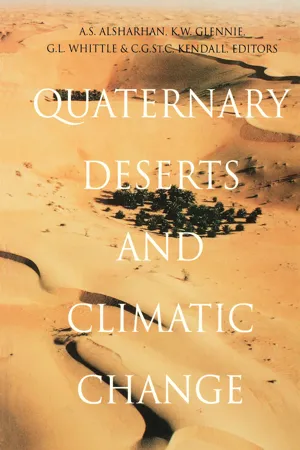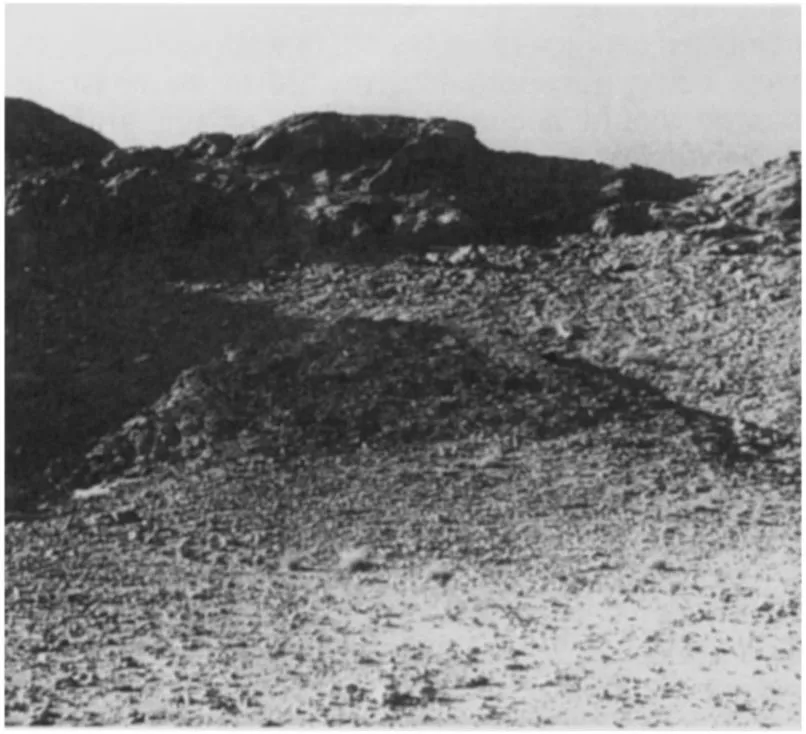
This is a test
- 632 pages
- English
- ePUB (mobile friendly)
- Available on iOS & Android
eBook - ePub
Quaternary Deserts and Climatic Change
Book details
Book preview
Table of contents
Citations
About This Book
These proceedings record the results of climate change in many areas which are hyper-arid deserts today but which, almost cyclically, at intervals of thousands or even hundreds of thousands of years, have had a much more humid climate.
Frequently asked questions
At the moment all of our mobile-responsive ePub books are available to download via the app. Most of our PDFs are also available to download and we're working on making the final remaining ones downloadable now. Learn more here.
Both plans give you full access to the library and all of Perlego’s features. The only differences are the price and subscription period: With the annual plan you’ll save around 30% compared to 12 months on the monthly plan.
We are an online textbook subscription service, where you can get access to an entire online library for less than the price of a single book per month. With over 1 million books across 1000+ topics, we’ve got you covered! Learn more here.
Look out for the read-aloud symbol on your next book to see if you can listen to it. The read-aloud tool reads text aloud for you, highlighting the text as it is being read. You can pause it, speed it up and slow it down. Learn more here.
Yes, you can access Quaternary Deserts and Climatic Change by A.S. Alsharhan,K.W. Glennie,G.L. Whittle in PDF and/or ePUB format, as well as other popular books in Physical Sciences & Geology & Earth Sciences. We have over one million books available in our catalogue for you to explore.
Information
1 Quaternary sedimentation and diagenesis
Geomorphology of cemented aeolian sands, Bowah Area, Oman
ABSTRACT: The geomorphology of cemented aeolian sands (miliolite) is well displayed in the Bowah area on the NW flank of Jebel Nakhl, Oman. The aeolian sand drapes both sides of a NE-SW trending ridge of Tertiary limestone. On its leeward (SE) side, the sand occurs as crude beds that dip about 30° towards the SE (150°), and are partly covered by a scree of Tertiary limestone sliding from higher on the slope. On the other side of the ridge, the sands form a saddle between two ridges and climb part way up the slope to its SE. The original bedding pattern is well displayed.
These aeolian sands consist predominantly of carbonate particles with minor amounts of ophiolite grains, mainly feldspar, and quartz grains. The carbonate particles are presumed to have been derived during a former high-latitude glaciation (the last or an earlier one?) from an exposed shallow sea floor beyond the present Batinah Coast, some 25 km to the north. Bedding attitudes imply that this glacially induced wind blew roughly from north to south. The ophiolite grains, on the other hand, would first have been transported northward from the Semail Nappe by fluvial (wadi) action, and then been reworked southward by the same northern winds. The final wind direction was probably modified by convection over the adjacent mountains as well as being controlled by the orientation of the ridges of Tertiary limestone. Similar cemented aeolian sands in the Ras al Hamra area of Muscat are described by Glennie and Gökdag in a companion paper (this volume).
1 INTRODUCTION
Cemented aeolian sands are widespread in parts of Oman, and they record aeolian activity during a significant part of the country’s Quaternary history. This paper presents the results of a preliminary investigation (Al-Belushi 1992) of cemented aeolian sands that drape the leeward flanks of steep ridges of Tertiary limestone and locally floor palaeovalleys between the ridges. Similar cemented aeolian sands are described from Ras al Hamra, west of Muscat, in a companion paper by Glennie and Gökdag. Figure 1 shows the distribution of some known localities of these miliolites.
2 GEOMORPHOLOGY AND LOCATION OF THE AEOLIAN SANDS
The ridges of Tertiary limestone (Fig. 2) trend NE-SW, and attain a height of some 50 m or more above the adjacent wadi plain, which is about 100 m above sea level. The Late Paleocene to Early Eocene limestones have an average dip of around 30° to the NW. They probably acquired that dip during mid-Late Tertiary uplift of Jebel Nakhl as part of the overall mountain-building process of the Oman Mountains.
The mountains themselves comprise a core of autochthonous rocks ranging from the Late Precambrian to Late Cretaceous in age, which are technically overlain by (1) the Hawasina, a system of complexly folded Permian to mid-Cretaceous deep-marine limestones and radiolarian cherts, which in turn is overlain by (2) the Semail ophiolite nappe. Early to mid-Tertiary limestones flank the mountains parallel to the Batinah Coast (Fig. 1). The products of erosion of the Oman Mountains have been carried towards the Gulf of Oman via a system of alluvial fans. These have a variable cover of thin aeolian sands, which to the west are overlain by some extensive patches of small linear dunes that trend NNE-SSW (Glennie 1970), whereas nearer to Muscat they are of transverse type and trend NE-SW. This change in dune orientation may be controlled in part by a variable pattern of convection over the adjacent mountains.
The cemented aeolian sands of the Bowah area drape both sides of the NE-SW trending limestone ridges. On the leeward (SE) side, the sands form crude beds that dip at about 30° towards the SE (150°), and are partly covered by a limestone scree that slid from higher on the slope (Fig. 3). On the other side of the same ridge, cemented carbonate aeolian sands occupy a saddle between it and the ridge to the NW, and climbs part way up the slope to its SE (Fig. 4). The original bedding pattern is well displayed, and reveals a very good record of a varying wind regime (Fig. 5).




3 SAND COMPOSITION
The cemented sands consist predominantly of carbonate particles. In thin section, they display a lot of carbonate cement holding together a mosaic of fractured quartz grains, magnetite, fragments of chert, pellets of mudstone, and ultramafic rock fragments. There are also some rare angular grains of feldspar and small-chambered foraminifera. Most of the noncarbonate grains are well rounded; they are interpreted to have been abraded during aeolian transport, and perhaps also an earlier history of fluvial transport. The remaining organic content of these sands is represented by original shell material, which possibly implies a fairly young age (<200 000 a?); some fossils were possibly reworked from the surrounding Tertiary limestones. For a more detailed petrographic description, the reader is referred to the paper by Glennie and Gökdag (this volume).
4 ENVIRONMENTAL INTERPRETATION
It is now generally accepted that times of high-latitude Pleistocene glaciations coincided with increased aridity and stronger winds in the world’s deserts and lower global sea level because so much water was tied up in the polar ice caps. Lower sea level resulted in continental shelves being exposed by as much as 120 to 130 m below present levels; because Oman is located in the tropics, in addition to other mineral grains, masses of shallow-marine carbonate fauna were exposed to deflation by the strong glacially induced winds.


The bedding attitudes of the cemented aeolian sands in the near-coastal areas of the Batinah Coast of Oman and the Arabian Gulf coast of the Emirates implies that the dominant sand-transporting wind in those areas at the time of their deposition was the northern (Shamal) wind. The most likely sources of the unconsolidated sand-size grains that were incorporated into the cemented aeolian sands were: (1) wadi sediments that were being transported northward to the coast; this source would account for most of the grains of ophiolite, feldspar, and chert, and 2) wind-blown sand deflated from the exposed continental shelf along the Batinah Coast; these sands would be rich in carbonate fragments, including some almost complete foraminifera, as well as a selection of the wadi-transported grains reworked back towards the mountains. There may also have been a percentage of carbonate dust particles derived by the powdering of the relatively weak carbonate grains during aeolian transport; because of its size, much of this powder could have been dissolved rapidly during any ensuing wetter climatic phase, and thus help to provide a good carbonate cement to bind the surviving grains. If true, then cementation is likely to have occurred during the period of higher rainfall that is known to have occurred south and west of the Oman Mountains during the build-up to the last glaciation, and also during the ‘Climatic Optimum’ of about 6–9 ka BP.
ACKNOWLEDGMENT
I am grateful to K. W. Glennie who encouraged me to write and reviewed this manuscript.Thanks are also extended to Professor A. S. Alsharhan, C. Kendall and Dr. G.L. Whittle for their comments on the paper.
REFERENCES
Al-Belushi, J.D. 1992. Geological mapping of Bowah-Halban area. B.Sc. Thesis, Sultan Qaboos University, Muscat.
Glennie K.W. & Gökdag, H. (this vol.). Cemented Quaternary Dune sands, Ras Al Hamra Housing Area, Muscat.
Glennie, K.W. 1970. Desert Sedimentary Environments. Developments in Sedimentology 14. Amsterdam: Elsevier.
Diagenesis in the Quaternary carbonate sediments of Saurashtra and Kachchh, Western India
ABSTRACT: The Saurashtra and Kachchh regions of Western India contain mainly three types of Quaternary carbonate sediments, viz. beach rocks, miliolites and stabilized sand dunes. The beach rocks and sand dunes are restricted to the coastal areas of Saurashtra, whereas the miliolites are widesprea...
Table of contents
- Cover
- Half Title
- Title Page
- Copyright Page
- Table of Contents
- Preface
- Acknowledgments
- 1 Quaternary sedimentation and diagenesis
- 2 Dunes and inland sabkhas
- 3 Fluvial or wadi systems
- 4 Quaternary climatic changes
- 5 Geochemical applications to Quaternary deserts
- 6 Application of remote sensing to desert environments
- 7 Quaternary analogs to ancient and recent sediments
- 8 Archaeology
- 9 Glossary
- Author index